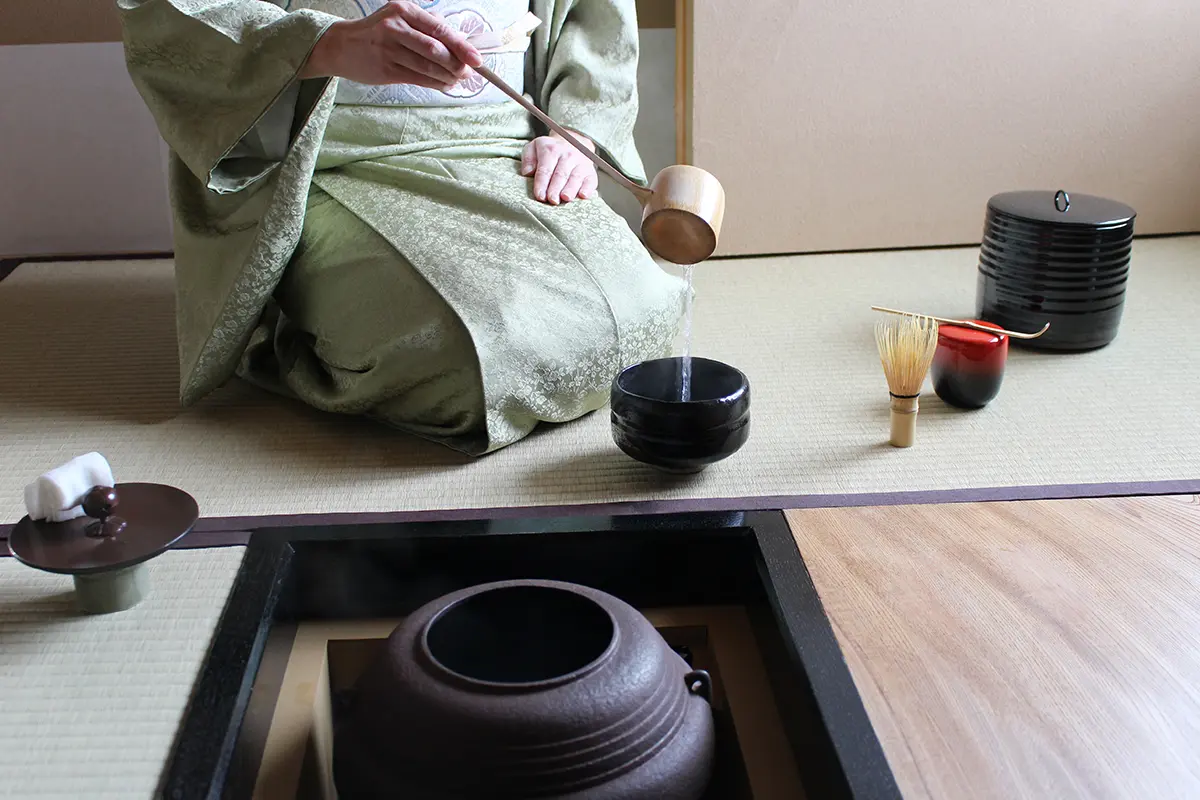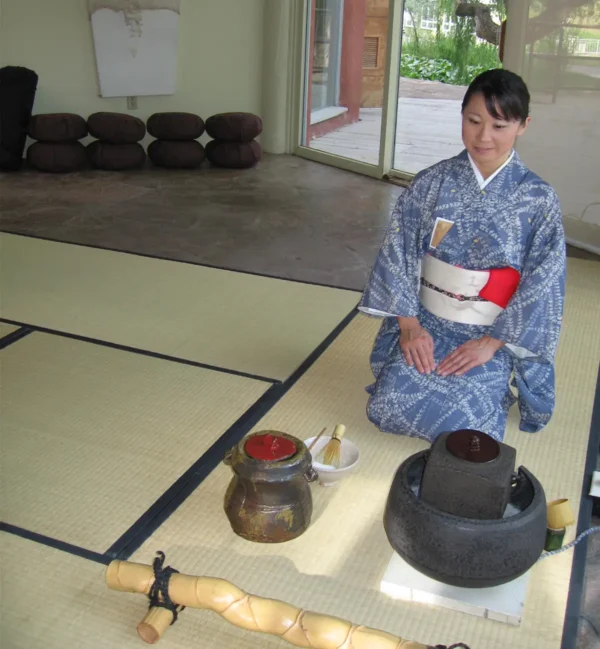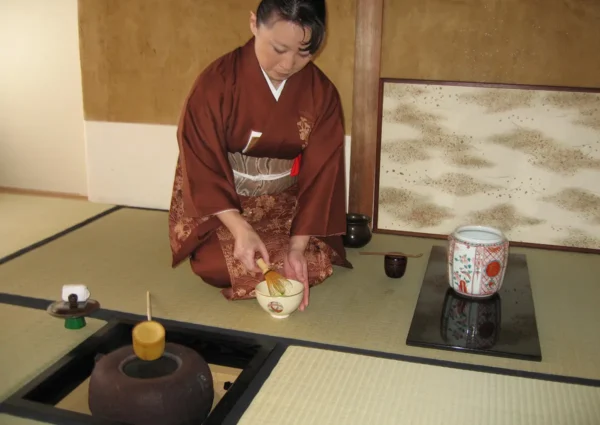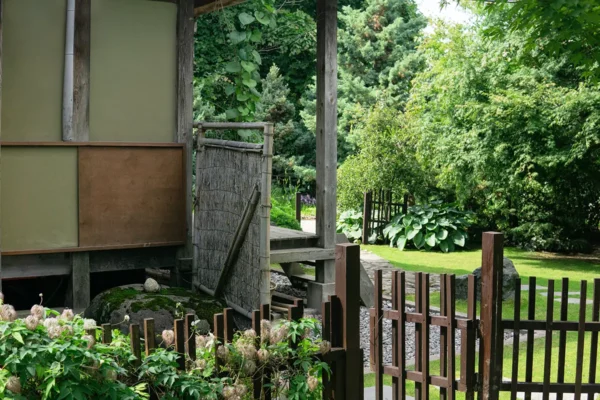

Table of Contents
Growing up in Japan, I had countless opportunities to take Japanese tea ceremony lessons. My high school even offered an after-school class dedicated to this traditional art. However, my first formal lesson occurred in Carrollton, Georgia, during my third year in the United States. This experience was likely triggered by a heightened sense of cultural identity and a desire to reconnect with my Japanese roots amid American culture.
The Way of Tea is more than just a ritual; it is a way of life for many Japanese people. The meticulous performance and deep meaning behind preparing a bowl of tea embody core Japanese cultural virtues, making learning the tea ceremony a lifelong journey. There is no end or perfection—only continuous improvement and deeper understanding.

Green tea was initially brought to Japan by Zen monks from China in the 9th century and evolved into a pastime for the military and the wealthy. The current form of the tea ceremony has remained largely unchanged for about 500 years since Sen no Rikyu established it. The earliest record of Rikyu indicates that he hosted a tea ceremony in 1537 at the age of sixteen, attended by highly-regarded cultural figures.
Rikyu became more prominent in historical records after he began serving the powerful samurai lord, Oda Nobunaga (1534-1582). After Nobunaga’s death, Rikyu served Nobunaga’s successor, Toyotomi Hideyoshi, as a tea master and cultural representative. Despite his political influence under Hideyoshi, Rikyu is primarily revered as the father of the traditional Japanese tea ceremony.
Traditional Japanese tea ceremonies still adhere to Rikyu’s procedures for making tea. More importantly, the spirit and values Rikyu instilled in the Way of Tea are embraced by many, even those who are not formal tea students. The foundation of the Way of Tea reflects deep-seated Japanese cultural values, and through the simple act of making a bowl of tea, Rikyu highlighted essential Japanese virtues. Learning and experiencing the Way of Tea can provide profound insights into Japanese culture, engaging both the mind and body. Rikyu’s influence on the Way of Tea remains one of the most significant in its history.
The Way of Tea involves many strict codes and formalities, but Rikyu infused it with the spirit of Japanese cultural virtues. He established four guiding principles: harmony, respect, purity, and tranquility (Wa-Kei-Sei-Jaku). These principles represent fundamental Japanese values.

Harmony (Wa): Harmony is crucial not only among people but also between humanity and nature. In a tea room, there should be harmonious interaction between the host and guests. The coordination of movements, the serving and receiving of tea, should resemble an art form. The tea room’s atmosphere, enhanced by the arrangement of hanging scrolls, flowers, tea tools, and the aroma of incense, should be in perfect balance, creating a peaceful environment.
Respect (Kei): Respect involves understanding and accepting others. It is a core concept of Japanese virtue to humble oneself and honor others. Mutual respect is cultivated when both parties appreciate and value each other. In the tea ceremony, recognizing the host’s and guests’ considerations is paramount.
Purity (Sei): Purity signifies cleanliness and orderliness, both physically and spiritually. Guests wash their hands and mouths before entering the tea room, a ritual similar to the one performed before entering shrines. This act is not only about physical cleanliness but also about purifying the mind. With a pure heart, harmony and respect naturally follow.
Tranquility (Jaku): Tranquility represents the ultimate peace and stillness that leads to selflessness. Before entering the tea room, guests wait in a designated area, often a Japanese garden, to prepare their minds. Upon entering, they first observe the hanging scroll to calm their minds. The serene environment, enhanced by the sound of boiling water, the aroma of incense, and the sight of fresh flowers, fosters self-reflection and mental clarity.
These four principles are essential to the Way of Tea and have become integral to Japanese culture. Rikyu’s wisdom applied these cultural features to the tea ceremony, making it a profound cultural practice.
In some temples, visitors can purchase a cup of tea and sweets to enjoy in front of a Zen garden. Kyoto is home to numerous cafes where you can savor a bowl of matcha. During formal tea ceremonies, sweets are served first, followed by tea. When tea is served, the front of the cup faces you, showcasing the bowl’s most beautiful side. Take a moment to admire the bowl’s artistry, then gently rotate it clockwise before taking your first sip. This respectful gesture preserves the bowl’s artistic integrity.
Experiencing the Way of Tea offers a unique glimpse into Japanese culture and values. Whether in a traditional tea room or a serene garden, the practice embodies harmony, respect, purity, and tranquility, inviting you to immerse yourself in the profound simplicity of making and enjoying a bowl of tea.
Submission successful. You will receive a confirmation email, shortly.